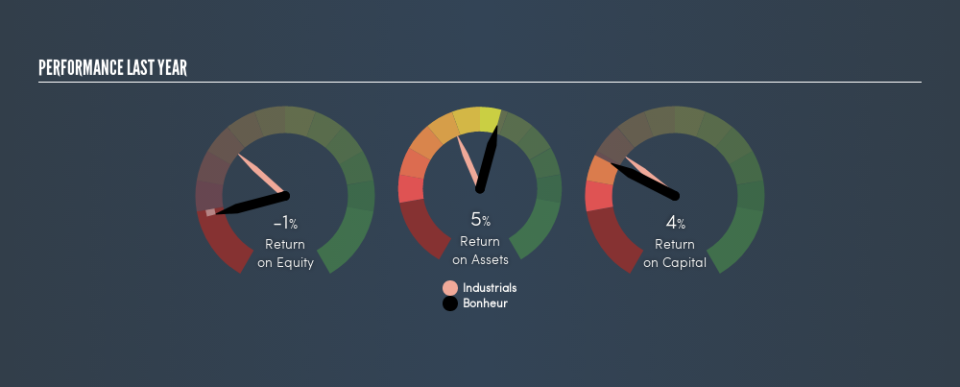Bonheur ASA’s (OB:BON) Investment Returns Are Lagging Its Industry

Today we'll look at Bonheur ASA (OB:BON) and reflect on its potential as an investment. Specifically, we'll consider its Return On Capital Employed (ROCE), since that will give us an insight into how efficiently the business can generate profits from the capital it requires.
First up, we'll look at what ROCE is and how we calculate it. Next, we'll compare it to others in its industry. And finally, we'll look at how its current liabilities are impacting its ROCE.
Return On Capital Employed (ROCE): What is it?
ROCE is a metric for evaluating how much pre-tax income (in percentage terms) a company earns on the capital invested in its business. All else being equal, a better business will have a higher ROCE. Overall, it is a valuable metric that has its flaws. Author Edwin Whiting says to be careful when comparing the ROCE of different businesses, since 'No two businesses are exactly alike.'
So, How Do We Calculate ROCE?
The formula for calculating the return on capital employed is:
Return on Capital Employed = Earnings Before Interest and Tax (EBIT) ÷ (Total Assets - Current Liabilities)
Or for Bonheur:
0.044 = kr704m ÷ (kr20b - kr4.0b) (Based on the trailing twelve months to June 2019.)
Therefore, Bonheur has an ROCE of 4.4%.
See our latest analysis for Bonheur
Does Bonheur Have A Good ROCE?
ROCE can be useful when making comparisons, such as between similar companies. Using our data, Bonheur's ROCE appears to be significantly below the 6.9% average in the Industrials industry. This performance could be negative if sustained, as it suggests the business may underperform its industry. Regardless of how Bonheur stacks up against its industry, its ROCE in absolute terms is quite low (especially compared to a bank account). Readers may wish to look for more rewarding investments.
You can click on the image below to see (in greater detail) how Bonheur's past growth compares to other companies.
It is important to remember that ROCE shows past performance, and is not necessarily predictive. Companies in cyclical industries can be difficult to understand using ROCE, as returns typically look high during boom times, and low during busts. This is because ROCE only looks at one year, instead of considering returns across a whole cycle. How cyclical is Bonheur? You can see for yourself by looking at this free graph of past earnings, revenue and cash flow.
Do Bonheur's Current Liabilities Skew Its ROCE?
Current liabilities are short term bills and invoices that need to be paid in 12 months or less. Due to the way the ROCE equation works, having large bills due in the near term can make it look as though a company has less capital employed, and thus a higher ROCE than usual. To counteract this, we check if a company has high current liabilities, relative to its total assets.
Bonheur has total assets of kr20b and current liabilities of kr4.0b. As a result, its current liabilities are equal to approximately 20% of its total assets. This is a modest level of current liabilities, which will have a limited impact on the ROCE.
Our Take On Bonheur's ROCE
Bonheur has a poor ROCE, and there may be better investment prospects out there. But note: make sure you look for a great company, not just the first idea you come across. So take a peek at this free list of interesting companies with strong recent earnings growth (and a P/E ratio below 20).
I will like Bonheur better if I see some big insider buys. While we wait, check out this free list of growing companies with considerable, recent, insider buying.
We aim to bring you long-term focused research analysis driven by fundamental data. Note that our analysis may not factor in the latest price-sensitive company announcements or qualitative material.
If you spot an error that warrants correction, please contact the editor at editorial-team@simplywallst.com. This article by Simply Wall St is general in nature. It does not constitute a recommendation to buy or sell any stock, and does not take account of your objectives, or your financial situation. Simply Wall St has no position in the stocks mentioned. Thank you for reading.

